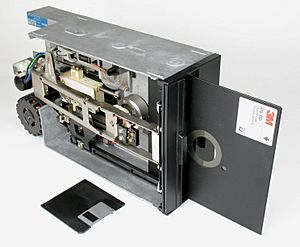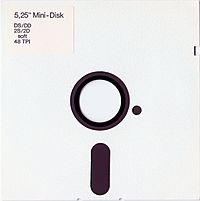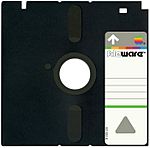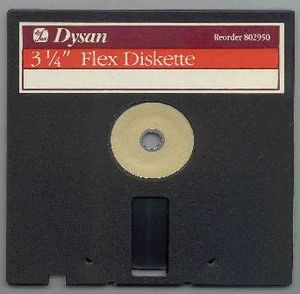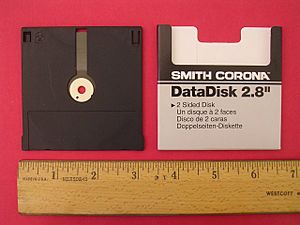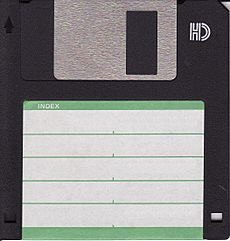History of the floppy disk facts for kids
A floppy disk was a type of storage for computers. It was a thin, flexible disk made of a special magnetic material, kept safe inside a rectangular plastic case. You used a floppy disk drive to read and write information onto it. Floppy disks were super popular from the 1970s to the 1990s. People used them to save data, make backups, and move files between different computers.
In 1967, at IBM in San Jose, engineers started working on the first floppy disk and its drive. It came out in 1972 as an 8-inch disk. Later, in 1976, the smaller 5¼-inch disks became common for word processing machines and personal computers. Then, in 1982, the even smaller 3½-inch format appeared. For a while, both the 5¼-inch and 3½-inch disks were very popular.
Floppy disks were used for almost 40 years! But by the mid-1990s, their use started to drop. Faster computer networks and new storage like USB flash drives and memory cards (which use flash memory) took over. A big moment was when the iMac computer came out in 1998 without a floppy disk drive. After 2000, floppy disks became rare, mostly used with old computers or industrial machines.
Contents
The First Floppy: 8-inch Disks
In the late 1960s, IBM needed a cheap way to load special programs into their new computer systems. They wanted a device that cost less than $200 and disks that cost less than $5.
A team at IBM, including David L. Noble, Donald L. Wartner, Herbert E. Thompson, Warren L. Dalziel, Jay Brent Nilson, and Ralph Flores, created the first floppy disk system. It was called the IBM 23FD Floppy Disk Drive System. The first disk was 8 inches wide and could hold 80 kilobytes of data. At first, the disk was bare, but dirt caused problems. So, they put it inside a plastic cover lined with fabric to keep dust away. IBM released this disk in 1971.
This new device was first used in 1971 to load programs for IBM's 2835 Storage Control Unit. Other companies soon saw that a floppy disk drive that could both read and write data would be very useful. In 1972, Memorex shipped the Memorex 650, which was the first floppy disk drive you could buy that could read and write. It held 175 kB of data.
In 1973, IBM released its first read/write floppy disk drive, the 33FD. It was part of the 3740 Data Entry System, which replaced old punched card machines. This new system used a "soft sector" way of recording data, storing almost 250 kB on a disk. This became known as the Single Sided Single Density (SSSD) format. It could hold as much data as 3000 punch cards!
In 1973, Shugart Associates was founded and became a top maker of 8-inch floppy disk drives. Their SA800 drive became the standard for how these drives looked and worked.
When the first microcomputers were made in the 1970s, the 8-inch floppy disk was one of the only "high-speed, mass storage" devices that regular people and small businesses could afford. The first microcomputer operating system, CP/M, came on 8-inch disks. However, these drives were still expensive, often costing more than the computer itself.
In 1976, IBM made a Double Sided Single Density (DSSD) format that held 500 KB. In 1977, they introduced a Double Sided Double Density (DSDD) format that held 1–1.2 MB.
The Smaller 5¼-inch Minifloppy
In 1976, An Wang from Wang Laboratories told Shugart Associates that the 8-inch disks were too big and costly for the desktop word processing machines he was making. He wanted a drive that cost around $100.
Shugart Associates then developed a smaller 5¼-inch drive. This new drive could store 98.5 KB, which later increased to 110 KB. The 5¼-inch drive was much cheaper than the 8-inch ones and quickly started appearing in CP/M computers.
Shugart's first 5.25-inch drive, the SA-400, was used in many early microcomputers. It set a standard for the 34-pin connection. This drive went on sale in late 1976 for $400, and a box of ten disks cost $60. Many other companies started making 5¼-inch drives, and by 1978, ten different manufacturers were producing them.
Apple used these SA-400 drive parts for their Disk II drive. Steve Wozniak, one of Apple's founders, created a special way of recording data called Group Coded Recording (GCR). This allowed Apple disks to store 140 KB, which was more than the standard 90–113 KB.
Early 5¼-inch drives could only read one side of the disk. Some people would cut a second "write-enable slot" and a hole into the disk's plastic cover. Then, they could flip the disk over and use the other side for more storage. This was called a "flippy disk". However, some thought this was risky because the disk might pick up dirt when spun in the opposite direction.
In 1978, Tandon introduced a double-sided drive, which doubled the storage capacity. This new "double sided double density" (DSDD) format could hold 360 KB. By the early 1980s, these soft sector, double density disks became very common. Smaller "half-height" drives also appeared.
For much of the 1970s and 1980s, the floppy drive was the main way to save data on word processors and microcomputers. Since many of these machines didn't have a hard drive, you would often load the OS from one floppy disk, then take it out and put in another disk with your program.
In 1984, IBM introduced the 5¼-inch "high density" (HD) disk format with their new IBM AT computers. These HD disks could store almost three times as much data as the 360 KB format. However, they sometimes had problems working with older drives because the read/write head was narrower.
It was hard to tell the difference between high-density and double-density 5¼-inch disks just by looking at them. This meant you could accidentally try to format a double-density disk to the higher capacity. This often seemed to work at first, but the data would eventually erase itself. This happened because high-density disks used a stronger magnetic coating, and the strong magnetic field from an HD drive would damage the weaker coating of a double-density disk.
By the end of the 1980s, the 5¼-inch disks were mostly replaced by the smaller 3½-inch disks. They slowly disappeared as the 1990s began.
The "Twiggy" Disk
During the creation of the Apple Lisa computer, Apple made a special disk format called Twiggy, also known as FileWare. It looked like a standard 5¼-inch disk but had extra openings on top. This drive was also planned for the first Apple Macintosh computer. However, it was removed from both the Mac and later Lisa versions because the drives were often unreliable. Apple decided to use the 3½-inch floppy disk from Sony instead.
The 3-inch Compact Floppy Disk
In the early 1980s, people realized the 5¼-inch format had its limits. It was still quite large, and the thin plastic case could easily bend or let dirt onto the disk.
Many companies tried to create better, smaller disks, including 2-inch, 2½-inch, 3-inch, and 3½-inch sizes. These new disks had advantages like being smaller and having a hard case with a sliding write protect switch. However, it was hard for any of them to become popular because the 5¼-inch format was already so widely used.
One of these formats was the 3-inch floppy disk, made by companies like Hitachi, Panasonic, and Maxell. Amstrad used a 3-inch drive in their Amstrad CPC and some Amstrad PCW computers. The ZX Spectrum +3 also used this drive.
All 3-inch disks were double-sided. If you had a drive that only read one side, you could flip the disk over to use the other side. Each side of a double-density disk held 180 KB, for a total of 360 KB per disk. Quad-density disks held 720 KB. These disks were more reliable because of their hard casing.
The main problem with the 3-inch format was its high price. Also, in 1984, Sony convinced Apple to use their 3½-inch drives in the Macintosh 128K computer. This made the 3½-inch drive the new standard, and the 3-inch format faded away.
Mitsumi's "Quick Disk" 3-inch Floppies
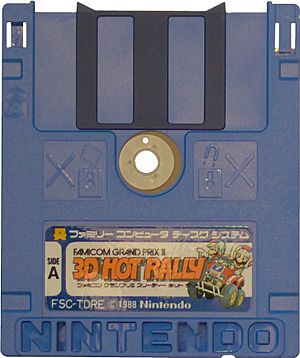
Another 3-inch format was Mitsumi's Quick Disk. These disks used a 2.8-inch magnetic disk inside different sized plastic cases. They had break-off tabs for write protection and a hole near the center.
The Quick Disk was most famously used in Nintendo's Family Computer Disk System (FDS) in Japan. Nintendo's version of the Quick Disk came in a 3-inch by 4-inch plastic case called the "Disk Card." Most FDS disks didn't have a cover to protect the magnetic part, but a few special games did.
Mitsumi's Quick Disk media were also used in 3-inch by 3-inch cases for many Smith Corona word processors. These disks were confusingly labeled "DataDisk 2.8-inch," referring to the size of the magnetic part inside.
The Quick Disk was also used in some MIDI keyboards and music samplers in the mid-1980s, like those from Roland, Korg, and Akai. It was a cheaper option than 5¼-inch drives for some 8-bit computer systems.
Unlike typical disk drives that read data in circles, the Quick Disk reads data in a continuous spiral track, similar to how a record player works. This made some people compare it more to a "tape-stream" device than a regular disk drive.
The 3½-inch Format
In 1981, Sony introduced their 3½-inch floppy disk (which was actually 90.0 mm by 94.0 mm). The first version could hold 161.2 KB of formatted data. A double-sided version came out in 1982. The first computer to use this format was Sony's SMC-70 in 1982. Like other new formats, it struggled to gain popularity because the 5¼-inch format was so dominant.
Things changed a lot in 1982 when many companies agreed on a new 3½-inch disk standard, based on Sony's design. In 1984, Apple chose this format for their new Macintosh computers. Then, in 1985, Atari used it for their ST line, and Commodore for their new Amiga. By 1988, the 3½-inch disk was selling more than the 5¼-inch disk. In South Africa, the 3½-inch format was often called a "stiffy disk" to show it was stiffer than the flexible 5¼-inch disks.
The 3½-inch disks had a big advantage: a rigid case with a sliding metal cover. This cover protected the disk surface much better than the 5¼-inch disks. When you put the disk into the drive, the drive would slide the metal cover aside to access the magnetic surface. The rectangular shape also made it impossible to insert the disk sideways by mistake.
These drives also had other benefits, like not needing a special "terminating resistor pack" and no longer needing an "index hole" on the disk.
However, the metal shutter could sometimes bend or get ripped off on old or roughly used disks. This didn't damage the disk itself, but it made it more open to dust. It could also get stuck inside the drive.
How 3½-inch Disks Evolved
Like the 5¼-inch disks, the 3½-inch disks also improved over time. When Apple launched the Macintosh in 1984, it used single-sided 3½-inch disk drives that could hold 400 KB. They used a special recording method called GCR.
Higher Capacities
Later, PC-compatible computers started using single-sided 3½-inch disks that held 360 KB (the same as a double-sided 5¼-inch disk). They used a different recording format called MFM. GCR and MFM disks were not compatible with each other, even though the physical disks looked the same.
In 1986, Apple introduced double-sided, 800 KB disks, still using GCR. Soon after, IBM started using 720 KB double-sided, double-density MFM disks in PCs like the IBM PC Convertible. The Amiga computers used MFM encoding on the same disks to store 1 MB (880 KB after formatting).
HD (High Density)
A new "high-density" (HD) format, often labeled "1.44 MB," came out in 1987. These disks could hold 1,474,560 bytes (or 1440 KiB), which was double the capacity of the 720 KiB disks. These HD disks had an extra hole in the case, opposite the write-protect notch. This hole allowed the drive to know if it was an HD disk. IBM used this format in their PS/2 series in 1987. Apple started using HD drives in 1988 with the Macintosh IIx. The HD floppy drive quickly became standard on almost all Macintosh and PC computers.
ED (Extra-High Density)
Even stronger magnetic coatings allowed for an "extra-high density" (ED) format that could hold 2880 KB. This was introduced in 1990 on computers like the NeXTcube and IBM PS/2 model 57. However, by this time, the increase in storage wasn't enough to make it widely popular. Other storage methods were becoming more common.



